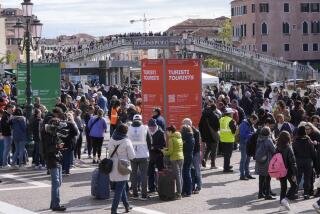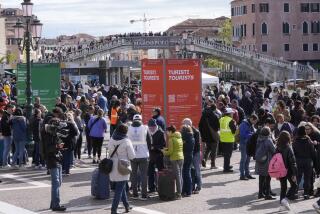Price Policy Was Penny Wise, Yuan Foolish
- Share via
BEIJING — His blond hair, blue eyes and 6-foot build gave him away.
Peter Juber was instantly identified as a foreigner visiting the Forbidden City here. So the 28-year-old German dug into his pocket and handed over the 55-yuan ($6.65) admission fee demanded of overseas tourists, as scores of Chinese citizens waltzed in at nearly a third of the price.
“I don’t think it’s right when you charge people from outside a different price from what you charge people who live here,” said Juber, catching a few sights in Beijing en route to Mongolia. “People expect to be treated the same as the locals. Otherwise you think they’re playing tricks and games with you.”
Ever since China began opening up to visitors in 1979, noncitizens have found their wallets squeezed for more than double what it costs locals, in some cases, to enjoy the same palaces, parks or stage performances.
But those days are numbered. In a major push for tourism, the government has announced that the dual-price system is on its way out as China tries to shed its reputation as an unfriendly place for travelers and lock into the top tier of the world’s tourist destinations.
Beijing has proclaimed this year “Visit China ‘97,” a motto plastered throughout the city on billboards, in neon lights, on posters, even on ads in hotel elevators.
Premier Li Peng personally welcomed attendees here for the Pacific Asia Travel Assn. annual conference, pledging better infrastructure and services and encouraging poor, remote areas of China to develop tourism prospects.
The assiduous courting of vacationers boils down to the bottom line: China is hungry for a bigger share of the $400 billion spent annually on leisure travel worldwide.
Already, the world’s most populous country is Asia’s most popular travel spot, raking in $10.2 billion last year from overseas visitors, according to government statistics. Tourism accounts for 3.7% of the national economy, a figure that He Guangwei, director of the National Tourism Administration, expects to rise to 5% by the end of the decade.
In 1996 alone, 51 million foreigners landed in China to visit everything from the “stone forest” in the southern city of Kunming to the ancient terra cotta warriors in central Xian.
But authorities have discovered that disgruntled foreigners forced to pay higher fees for admissions, airlines and railways do not make the best evangelists.
“I travel several times a year, and a price hike as a visitor . . . can be irritating and leave a bad impression,” wrote a British tourist in a letter to the editor of the China Daily.
For major tourist sites, China’s State Planning Commission, which sets ticket charges, hopes to implement uniform pricing schedules by the end of the year.
By Western standards, the price differential is relatively small: The gap between a ticket for foreigners and one for locals at the Forbidden City equals about $4.25. It is primarily the annoyance factor that sours the experience.
But some overseas travelers, while unsympathetic toward the system, hold no grudge against its beneficiaries--the Chinese themselves, whose annual per capita income is less than $1,000.
“It’s still very cheap for Western tourists. People here don’t have much money, so I think it’s OK,” said camera-toting Kay Roschmann, 25, of Hamburg, Germany. “Two days ago we paid $7 for Peking duck, so it’s not so bad.”
(BEGIN TEXT OF INFOBOX / INFOGRAPHIC)
Price List
Visitors to China pay more than Chinese citizens for everything from admission tickets at big tourist attractions to domestic air travel.
ADMISSION TO ...
*--*
Foreigners Locals Forbidden City $6.65 $2.42 Summer Palace $4.23 $2.42 Great Wall at Badaling $3.63 $2.42
*--*
ROUND-TRIP AIR FARES
*--*
Foreigners Locals Kunming $496 $302 Shanghai $266 $177 Xian $237 $169
*--*
Note: Air fares are between Beijing and the destination listed. They are economy class on Air China.
More to Read
Sign up for The Wild
We’ll help you find the best places to hike, bike and run, as well as the perfect silent spots for meditation and yoga.
You may occasionally receive promotional content from the Los Angeles Times.







